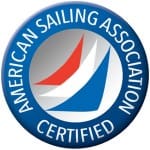ASA created a quiz a while back with one of the questions having to do with heaving to. Surprisingly, many people got the answer wrong, which led us to believe not everyone is out there heaving to! In fact, maybe they’re out there not even knowing what it means to heave to. So let’s go over it..
To heave to is to park the boat while out at sea. It’s mainly a heavy weather defense strategy but some people use the tactic to delay a harbor entrance for morning light, fix something or possibly just to have a little lunch at sea. As an example of how effective heaving to can be to endure through heavy weather, 26 sailors hove to in the infamous Fastnet Race where 18 people died in a horrific storm – none of those boats suffered any serious damage, let alone rolled or capsized.
Steps For Heaving To
- To lie on the tack opposite of the one you’re on, sheet the jib in tight, tack and leave the jibsheet cleated. As the boat passes through head to wind, the jib, held by the windward sheet, will set aback and push the bow downwind. Hold the mainsheet on the winch with its clutch open.
- Now steer the boat back toward the wind and make adjustments with the helm and the mainsheet until the boat is lying at a steady attitude to the wind on a close reaching heading. Normally, the wheel would be turned to windward. The mainsail might or might not need to be luffing.

 ASA TIP: How an individual boat heaves-to is a a function of many factors; design, keel type and relative sizes of the jib and mainsail are just some of them. So it might take a little practice and adjustments to figure it our for your boat.
ASA TIP: How an individual boat heaves-to is a a function of many factors; design, keel type and relative sizes of the jib and mainsail are just some of them. So it might take a little practice and adjustments to figure it our for your boat.










